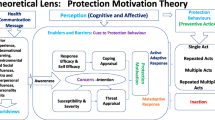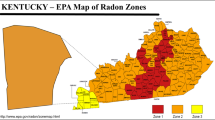Abstract
Indoor radon exposure is the second leading cause of lung cancer in the United States, yet radon risk reduction programs often struggle to increase home radon testing rates. This study compared two outreach methods to improve home radon testing and examined the association between home radon levels and geologic data in Central Appalachian communities in Tazewell County, Virginia, and Mercer County, West Virginia. We recruited 327 residents via phone and 211 residents via in-person workshops in 2016 and 2017. In total, 538 radon test kits were distributed to residents for deployment in their homes and subsequent shipment to a certified laboratory for analysis. We received 225 valid test results, which were subsequently linked to geologic units derived from the United States Geological Survey based on geocoded addresses. Results indicate that participants recruited by phone were more likely to complete the home radon test than those recruited in-person from workshops. Of seven geologic formation categories in the study area, dolomite formations from the Cambrian–Ordovician period were associated with the highest median radon value, 4.25 pCi/L (0.38–124.45 pCi/L). Our results suggest that effectiveness of radon risk reduction programs may be improved by phone education and test kit distribution campaigns, targeting homes on geological formations previously associated with heightened radon levels.


Similar content being viewed by others
References
Air Chek Inc. (2017) Interactive radon map. http://county-radon.info/. Accessed 18 Dec 2017
Air Chek Inc. (2018) Short-term activated charcoal radon gas test kit. https://www.radon.com/radon_airchek/. Accessed 12 July 2018
Alpha Energy Laboratories (2018a) Radon test information sheet. https://www.doctorhomeair.com/PDF/AE-english.pdf. Accessed 12 July 2018
Alpha Energy Laboratories (2018b) Short-term activated charcoal test kit. https://www.doctorhomeair.com/radontest/. Accessed 12 July 2018
Barbosa-Lorenzo R, Barros-Dios JM, Raíces Aldrey M, Cerdeira Caramés S, Ruano-Ravina A (2016) Residential radon and cancers other than lung cancer: a cohort study in Galicia, a Spanish radon-prone area. Eur J Epidemiol 31:437–441. https://doi.org/10.1007/s10654-016-0134-x
Barbosa-Lorenzo R, Barros-Dios JM, Ruano-Ravina A (2017) Radon and stomach cancer. Int J Epidemiol 46:767–768. https://doi.org/10.1093/ije/dyx011
Butler KM, Huntington-Moskos L, Rayens MK, Wiggins AT, Hahn EJ (2018) Access to free home test kits for radon and secondhand smoke to reduce environmental risks for lung cancer. J Environ Health 81:E1
Casey JA, Ogburn EL, Rasmussen SG, Irving JK, Pollak J, Locke PA, Schwartz BS (2015) Predictors of indoor radon concentrations in Pennsylvania, 1989–2013. Environ Health Perspect 123:1130–1137. https://doi.org/10.1289/ehp.1409014
Centers for Disease Control and Prevention (2017a) Behavioral risk factor surveillance system (BRFSS): 2016 BRFSS survey data and documentation. Centers for Disease Control and Prevention. https://www.cdc.gov/brfss/annual_data/annual_2016.html. Accessed 12 July 2018
Centers for Disease Control and Prevention (2017b) Data use restrictions. Centers for Disease Control and Prevention. https://wonder.cdc.gov/datause.html. Accessed 12 July 2018
Dicken CL, Nicholson SW, Horton JD, Kinney SA, Gunther G, Foose MP, Mueller JAL (2005) Integrated geologic map databases for the United States: Delaware, Maryland, New York, Pennsylvania, and Virginia. U.S. Geological Survey Open-File Report 2005-1325, U.S. Geological Survey, Reston, VA
Environmental Law Institute (2018) Radon control in new home construction: developments in state policy. https://www.eli.org/buildings/radon-control-new-home-construction-1. Accessed 4 July 2018
Environmental Protection Agency (2013) Home buyer’s and seller’s guide to radon. Environmental Protection Agency, Washington, DC
Environmental Protection Agency (2015) The national radon action plan—a strategy for saving lives. Environmental Protection Agency, Washington, DC
Environmental Protection Agency (2016) A citizen’s guide to radon: the guide to protecting yourself and your family from radon. Environmental Protection Agency, Washington, DC
Environmental Protection Agency (2017a) Building codes for radon-resistant new construction (RRNC). Environmental Protection Agency, Washington, DC
Environmental Protection Agency (2017b) EPA map of radon zones. Environmental Protection Agency, Washington, DC
Environmental Protection Agency (2017c) Health risk of radon. Environmental Protection Agency. https://www.epa.gov/radon/health-risk-radon#who. Accessed 18 Dec 2017
Erees FS, Yener G (1999) Radon levels in new and old buildings. In: Baumstark-Khan C, Kozubek S, Horneck G (eds) Fundamentals for the assessment of risks from environmental radiation. Springer Netherlands, Dordrecht, pp 65–68. https://doi.org/10.1007/978-94-011-4585-5_9
Field RW, Steck DJ, Smith BJ, Brus CP, Fisher EL, Neuberger JS, Lynch CF (2001) The Iowa radon lung cancer study—phase I: residential radon gas exposure and lung cancer. Sci Total Environ 272:67–72. https://doi.org/10.1016/S0048-9697(01)00666-0
Hahn EJ, Gokun Y, Andrews WM, Overfield BL, Robertson H, Wiggins A, Rayens MK (2015) Radon potential, geologic formations, and lung cancer risk. Prev Med Rep 2:342–346. https://doi.org/10.1016/j.pmedr.2015.04.009
Horton JD (2017) The State Geologic Map Compilation (SGMC) geodatabase of the conterminous United States (ver. 1.1, August 2017), U.S. Geological Survey data release. https://doi.org/10.5066/F7WH2N65
Hystad P et al (2014) Geographic variation in radon and associated lung cancer risk in Canada. Can J Public Health Revue Canadienne de Santé Publique 105:e4–e10
Ielsch G, Cuney M, Buscail F, Rossi F, Leon A, Cushing ME (2017) Estimation and mapping of uranium content of geological units in France. J Environ Radioact 166:210–219. https://doi.org/10.1016/j.jenvrad.2016.05.022
James K, Otton (1993) Preliminary geologic radon potential assessment of Missouri. U.S. Geologic Survey, Washington, DC
Kemski J, Siehl A, Stegemann R, Valdivia-Manchego M (2001) Mapping the geogenic radon potential in Germany. Sci Total Environ 272:217–230. https://doi.org/10.1016/S0048-9697(01)00696-9
Kentucky Geologic Survey (2018) Uranium, radon, and thorium. http://www.uky.edu/KGS/minerals/im_uranium.php. Accessed 3 July 2018
Krewski D et al (2005) Residential radon and risk of lung cancer: a combined analysis of 7 North American case–control studies. Epidemiology 16:137–145. https://doi.org/10.1097/01.ede.0000152522.80261.e3
Krewski D et al (2006) A combined analysis of North American case–control studies of residential radon and lung cancer. J Toxicol Environ Health Part A 69:533–597
Leventhal JS (1981) Pyrolysis gas chromatography-mass spectrometry to characterize organic matter and its relationship to uranium content of Appalachian Devonian black shales. Geochim Cosmochim Acta 45:883–889. https://doi.org/10.1016/0016-7037(81)90116-2
Miles JCH, Appleton JD (2005) Mapping variation in radon potential both between and within geological units. J Radiol Prot 25:257
Molla AR, Wampler PJ (2017) Household radon gas occurrences and geographic distribution in Western Michigan. J Environ Health 80:16–20
National Research Council (1999) Health effects of exposure to radon: BEIR VI, vol 6. National Academies Press, Washington, DC
Nicholson SW, Dicken CL, Horton JD, Labay KA, Foose MP, Mueller JAL (2005) Preliminary integrated geologic map databases for the United States: Kentucky, Ohio, Tennessee, and West Virginia: U.S. Geological Survey Open-File Report 2005-1324. U.S. Geological Survey, Reston
Rinker GH, Hahn EJ, Rayens MK (2014) Residential radon testing intentions, perceived radon severity, and tobacco use. J Environ Health 76:42
Smethurst MA, Strand T, Sundal AV, Rudjord AL (2008) Large-scale radon hazard evaluation in the Oslofjord region of Norway utilizing indoor radon concentrations, airborne gamma ray spectrometry and geological mapping. Sci Total Environ 407:379–393. https://doi.org/10.1016/j.scitotenv.2008.09.024
Sundal AV, Henriksen H, Soldal O, Strand T (2004) The influence of geological factors on indoor radon concentrations in Norway. Sci Total Environ 328:41–53. https://doi.org/10.1016/j.scitotenv.2004.02.011
US Census Bureau (2010) TIGER/Line® with selected demographic and economic data. https://www.census.gov/geo/maps-data/data/tiger-data.html. Accessed 15 July 2018
US Geological Survey (2018a) Geologic maps of US states. https://mrdata.usgs.gov/geology/state/. Accessed 21 Dec 2018
US Geological Survey (2018b) Geologic units containing black shale. https://mrdata.usgs.gov/geology/state/sgmc-lith.php?text=black%20shale. Accessed 11 Nov 2018
Wang Y, Ju C, Stark AD, Teresi N (2000) Radon awareness, testing, and remediation survey among New York state residents. Health Phys 78:641–647
World Health Organization (2009) WHO handbook on indoor radon: a public health perspective. World Health Organization, Geneva
Zahnd WE, Mueller-Luckey GS, Ratnapradipa K, Smith T (2018) Predictors and spatial variation of radon testing in Illinois, 2005–2012. J Public Health Manag Pract 24:e1–e9
Zhukovsky M, Yarmoshenko I, Kiselev S (2012) Combination of geological data and radon survey results for radon mapping. J Environ Radioact 112:1–3. https://doi.org/10.1016/j.jenvrad.2012.02.013
Acknowledgements
Special thanks are extended to Ryan Paris from the Virginia Department of Health for guidance and support throughout this project and Paul Wolff from the University of Alabama (UAB), Center for the Study of Community Health (CSCH) Survey Research Unit for management of efficient phone recruitment. This project was supported by the Virginia Department of Health (VDH), Office of Radiological Health, and the United States Environmental Protection Agency (US EPA) via a contract with Virginia Tech investigators (MOU No. VDH-16-631-0135) and a Virginia Tech Institute for Critical Technology and Applied Sciences Diversity and Inclusion Seed Grant. A subcontract between Virginia Tech and UAB CSCH Survey Research Unit supported phone recruitment of participants.
Author information
Authors and Affiliations
Corresponding author
Additional information
Publisher’s Note
Springer Nature remains neutral with regard to jurisdictional claims in published maps and institutional affiliations.
Electronic supplementary material
Below is the link to the electronic supplementary material.
Rights and permissions
About this article
Cite this article
Wu, C.Y.H., Bennett, M., Fox, K. et al. Geological data and outreach methods for designing targeted home radon testing programs. Environ Earth Sci 78, 120 (2019). https://doi.org/10.1007/s12665-019-8123-5
Received:
Accepted:
Published:
DOI: https://doi.org/10.1007/s12665-019-8123-5




